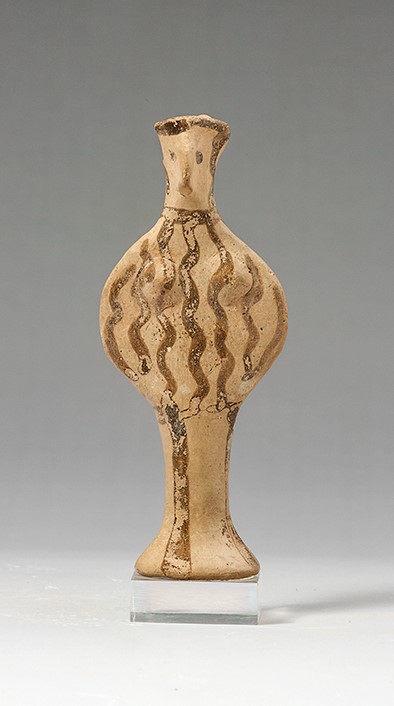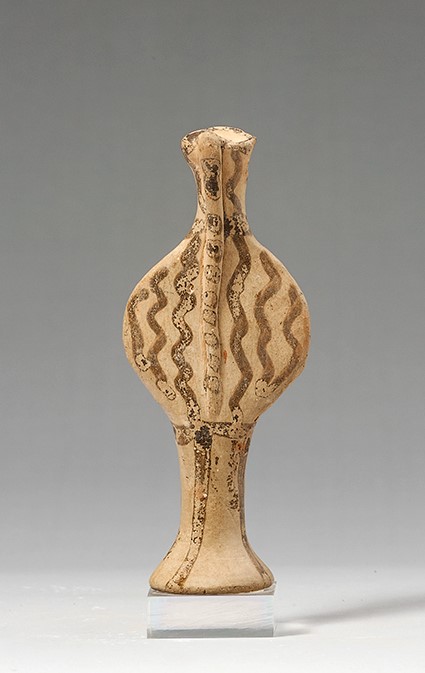Acquisition number: 1965.05
Intact and in good condition save for some wearing of the paint. Hard pale grey-buff clay with mid-brown paint.
Stylized representation of a female in a long dress with a pig-tail hanging down her back. Only the woman’s nose, breasts, head-dress and pig-tail are modelled. Several wavy lines show the soft folds of the upper part of the drapery, but below the hips they are continued as just four straight lines. A series of dots decorates the pig-tail. The base of the figurine is concave.
Title: Mycenaean Phi-Figurine - 1965.05
Acquisition number: 1965.05
Author or editor: J.R. Green
Culture or period: Mycenaean Late Helladic
Date: Mycenaean Late Helladic III A2: Later 14th century BC.
Material: Clay
Object type: Sculpture and figurines
Dimensions: 45mm (w) × 110mm (h)
Origin region or location: Greece
Display case or on loan: 1
Keywords: Mycenaean, Figurine, Late Helladic
Christie's, Sale Cat., 17 May 1965, no. 160 (ill.); J.R. Green with B. Rawson, Catalogue of Antiquities in the Australian National University, A.N.U., Canberra, 1981 82.
1965.05
Mycenaean Phi-Figurine
Purchased. Ht 11cm; width 4.5cm.
Intact and in good condition save for some wearing of the paint. Hard pale grey-buff clay with mid-brown paint.
Stylized representation of a female in a long dress with a pig-tail hanging down her back. Only the woman’s nose, breasts, head-dress and pig-tail are modelled. Several wavy lines show the soft folds of the upper part of the drapery, but below the hips they are continued as just four straight lines. A series of dots decorates the pig-tail. The base of the figurine is concave.
Phi-figurines (the name comes from the similarly shaped Greek letter) are found all over the area of Mycenaean activity. They were first made in Late Helladic III A 2 (fourteenth century) and continued into Late Helladic III B (thirteenth century); our piece probably belongs to the later part of the fourteenth century.
Their use is not known. Many have been found in houses and in votive deposits and they are particularly common in children’s graves. The figurines may well have some religious significance, but they were probably not intended (as were the miniature figures in Egyptian tombs) as servants of the dead.
A definitive study of these figurines is that by Elizabeth French, “The Development of Mycenaean Terracotta Figurines”, Annual of the British School at Athens 66, 1971, 101-187 (see esp. 116ff.). See more generally R.A. Higgins, Greek Terracottas (London 1967), esp. pl. 4f, and id., Minoan and Mycenaean Art (London 1967) 124-125 fig. 151; E. Vermeule, Greece in the Bronze Age (Chicago and London 1964) 221-222. On their role and function, see A. Pilali-Papastémiou, “Idéologie et commerce: le cas des figurines mycéniennes”, Bulletin de Correspondance Hellénique 122, 1998, 27-52; on their chronology, I. Weber-Hiden, “Zur Datierung mykenischer Idole”, Archaeologisches Korrespondenzblatt 15, 1985, 307-312.
Compare 1991.05 (Mycenaean Psi-Figurine) in this catalogue.
Christie's, Sale Cat., 17 May 1965, no. 160 (ill.); J.R. Green with B. Rawson, Catalogue of Antiquities in the Australian National University, A.N.U., Canberra, 1981 82.

